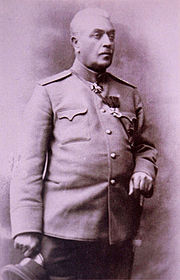By: Aram Hovasapyan
It is all too common among us Armenians for the conversation around the dinner or coffee table to drift to the tragedies of Armenian history followed by the long debate of where we would be if things had worked out differently. Whether discussing these issues with family or patriotic Armenian friends, the one name that invariably finds itself in the center of the conversation is that of the legendary fedayee, Andranik Ozanyan. Having a strong background in Armenian history, I find it quite distressing that from all the monumental figures that took great measures to allow for the establishment of an independent Armenian republic in 1918, Andranik is usually the only one known to old and young Armenians alike.
Many of us grew up singing the fedayee songs that martyrized men like Andranik, Serob Aghbyur, and Gevork Chavush. This was a sign of a correct Armenian upbringing. These men were known for their heroic deeds in working for the Armenian cause. However, I want to familiarize you with other great men who left an indelible mark in Armenia’s history, with whom you may not be so familiar with.

First up is General Tovmas Nazarbekian. Educated in the military academy in Moscow, Nazarbekian saw action early on in the Russo-Turkish War of 1877-78 and the Russo Japanese War in 1904-05. His actions during World War I and into 1920 proved critical for the formation and maintenance of an independent Armenian Republic. By the end of 1916, Russian troops along with Armenian volunteer units had advanced into the Ottoman provinces of Van, Erzerum, Bitlis, and Trebizond, the lands allotted to them by the Sykes Picot Agreement. Due to the mass desertion of Russian troops on the Turkish Front after the Bolshevik Revolution, the anti-Bolshevik Russian Army Command formed the Armenian Army Corps and placed General Nazarbekian in command with the mission to defend the vast territorial gains in Western Armenia. Under Nazarbekian’s command were three substrength divisions, one of them commanded by none other than Andranik.
The outnumbered and ill-equipped Armenian forces could not hold back the renewed Turkish offensive, and by May 1918, Turkish Armies had almost reached Yerevan. During May 24-28, Nazarbekian, along with Garegin Nzhdeh, led Armenian forces to halt the Ottoman advance in the battle of Karakilisa (modern day Vanadzor , soviet Kirovakan). Along with Karakilisa, the Armenian victories at the battles of Sardarapat and Bash-Aparan, where Armenian forces were led by General Movses Silikian and Drastamat Kanayan respectively, were instrumental in stopping the Ottoman offensive and giving an opportunity for Armenians to declare their independence and to negotiate with the Turks the establishment of a small, yet independent Armenian republic in the Treaty of Batum on June 4, 1918. One should appreciate the gravity of the treaty in recognizing an independent Armenia, since Turkish forces held positions only seven kilometers from Yerevan as the treaty was signed. As unplanned, unexpected, and remarkable the declaration of an independent republic was, it provided for the basis of a soviet Armenia and a second independent republic. Had Armenian forces lost any of these battles, historian Christopher Walker says “it is perfectly possible that the word Armenia would have henceforth denoted only an antique geographical term.”
General Nazarbekian continued to loyally serve the Republic of Armenia until he was arrested in January 1921 following the Sovietization of Armenia, but released shortly thereafter.
In the next blog, I will continue to share with you the stories of the other truly important Armenians that played a big role in the formation of an independent Armenia. Stay tuned for more.